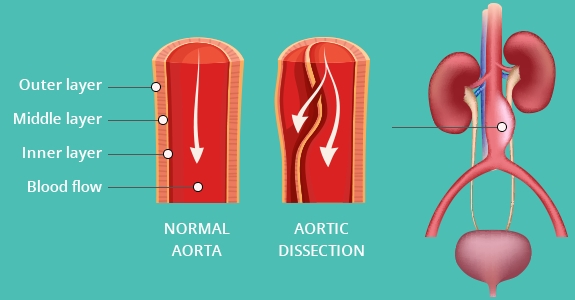Blood vessel walls are comprised of three layers, each of which serve an important function. Whereas an aneurysm is a dilation of the vessel wall, a dissection is a tear in the inner-most lining. When this tear occurs, it can lead to life-threatening complications. Read on to learn more about aortic dissection and follow the links below to see how we treat them.

Aortic Dissection
Aortic Dissection

Anatomy of a Blood Vessel
The three layers of blood vessels are called the intima, media, and adventitia (ad-ven-tish-a). The inner-most layer, or intima, is the thinnest and is the portion that actually contacts the blood stream. The media is the middle layer. The media has several important functions and its thickness depends on what vessel we are talking about. The aorta is the largest blood vessel in the body. It must be able to handle a high volume of blood moving quickly, and at high pressure. As such, the aortic media is the thickest and most elastic in the body. The adventitia is the outer-most layer comprised of mostly of connective tissue. The adventitia is the strongest layer.
What Causes an Aortic Dissection?
The most common cause of aortic dissection is hypertension (high blood pressure). As blood pressure gets higher, it increases the shear forces within the aorta. This effect is greatest in the aortic arch in chest where the vessel turns 180 degrees. Directly off the heart, blood initially travels upwards towards the head. The aortic arch then redirects flow down to the rest of the body. If shear forces become too high, the intima may tear away from the media. Blood then travels between the two layers and separates, or dissects them. The torn intima forms what we call a, “dissection flap” which has the potential to cause additional problems.
What are the symptoms of an Aortic Dissection?
The main symptom of a dissection is extreme chest pain that radiates towards the back, and possibly between the scapulae. The pain tracks along the length of the tear in the vessel. The presence of additional symptoms depends on the extent of the tear and anatomy of the dissection flap.
The tear in the aorta may involve the origins of other blood vessels coming off the aorta. These vessels supply vital organs such as the brain, spinal cord, kidneys, intestines, and the legs. When flow through these other vessels is compromised, additional symptoms of an aortic dissection may include stroke, paralysis, kidney failure, intestinal ischemia, or limb-threatening ischemia.
Treatment of Aortic Dissection
Treatment of an aortic dissection is determined based on symptoms. Regardless of whether or not surgery is needed, the mainstay of therapy will first involve controlling blood pressure and heart rate, often with IV medications. Patients will be admitted to the ICU for intensive monitoring. Occasionally, medical management is all that is required, but in some cases, surgery must be performed. Click below to learn about surgical management of aortic dissection.
Surgical Management of Aortic Dissection - If an aortic dissection has compromised blood flow to a vital organ, or if blood pressure cannot be controlled despite maximal doses of medications, surgery may be necessary. TEVAR (link to TEVAR section of TAA) is performed to repair the aorta. Occasionally, additional stents may needed in other vessels to restore flow.
Aortic dissection is a complex vascular problem. In the acute setting, it is a life-threatening emergency. If surgery is avoided at the outset, an aortic dissection becomes a chronic condition. Our surgeons are specifically trained to manage this challenging condition.
If you have been diagnosed with an aortic dissection, or have questions about the diagnosis, please give us a call: 775-323-3000.
